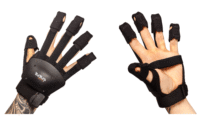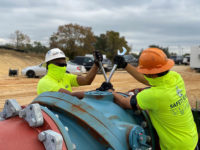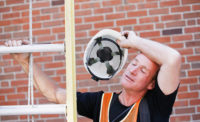Pankaj Singh is a recent Ph.D. graduate in mechanical engineering from Cornell University. He is also a co-founder of OrthoFit Inc, a new company developing smart wearables and software that automate and enhance workplace ergonomic assessments and prevent repetitive motion injuries. The technology automates the process of safety risk assessment while simultaneously providing new enhanced safety metrics. Additionally, data can be collected on employees over the entire course of the day to identify potential ergonomic issues and fatigue. The first product in development is a smart wearable glove for detection/prevention of hand/wrist injuries. The glove captures hand and wrist position/movement, vibration and grip force. This glove is nearing its production-ready phase and is currently planned to be used in food processing industry.
ISHN interviewed Pankaj by email to discuss smart glove wearables.
The industrial safety glove market is intensely competitive and has been for years. What’s your business plan for breaking into this crowded market with OrthoFit?
We are different from the existing safety glove market.
We are not a safety glove company; instead we are a smart wearable company designing technology to collect relevant data on body dynamics of people. We have found a niche application of this data collection capability in improving safety evaluations. After talking with many ergonomists and health and safety officers working for various manufacturing companies, the issue of ineffective safety evaluations was a common theme. With the help of our technology, safety evaluations can be made much faster and accurate, to overall improve the quality of such evaluations.
What’s your plan for selling safety professionals on a wearable glove? Safety professionals don’t have large budgets, safety is not seen as any sort of profit center, so funds are limited and spending on something untried and original often proceeds very cautiously.
We are developing these smart wearables in close collaboration with industrial ergonomists and health and safety officers. We gather their feedback regularly on what quantity they want us to measure. With the help of our hardware development team, we have come up with a glove which can collect data on hand movement relative to the wrist and grip force. We have embedded unnoticeable electronic components within the glove, which will provide us data for the mentioned quantities.
The sleekness of the glove will ensure that it does not interfere with the work routine of the employee. Prior to this, data collection was performed manually and was not accurate. For quantities like grip force, which are extremely crucial for safety evaluation, our technology is the first one to measure it.
Our technology's application is in automating the safety evaluation, training employees on best work habits and risk assessment of industrial infrastructure. These applications are not seen as profit centers, but they do drain a significant amount of money out of employers’ pockets. Employers want to reduce these monetary losses by reducing the number of injuries.
The way our technology is priced, its annual operating cost is the same amount as employers would spend on a single repetitive motion-induced injury (approximately $30,000). After conversing with a number of big corporations that spend a significant amount of their revenue toward employee wellness programs, safety evaluations and equipment, allocating funds for some proactive safety technique can benefit them a lot.
There is a difference between consumer wearables and industrial safety wearables. Consumers who buy wearables want the health information provided; no one is telling them they have to wear these Fitbits, etc. But in the workplace, workers might resist being told to wear a smart glove that will track and monitor the worker all day long, and give personal data about hand and wrist position/movement, vibration and grip force to the safety department to assess. In the consumer world, users of wearables are not giving away their personal data to anyone. In industry, that privacy is gone. How will you deal with this potential fear of Big Brother attitude and potential resistance?
Think about the way evaluations are performed right now. A trained ergonomist will look at an employee while they are working. They will then go back and analyze the information that they collected during their evaluation. We come into the picture by automating the process. We are just changing the methodology; instead of a person watching an employee, a glove will collect the data, making the data collection more accurate and efficient.
To be honest, I cannot comment on the potential resistance. But on our end we can promise that these gloves are safe to use, no health risk is involved, and the data is purely meant for ergonomic evaluation purposes.
How much does your smart glove cost? Can a smart glove as you describe, delivering the data you describe, be produced at a price point that will allow every employee in a shop to wear the glove? And gloves wear out rather quickly. What are you doing to make your glove durable and comfortable and cut resistant?
At this point we are developing this wearable technology for the meat processing industry. The employees in this industry are wearing three layers of glove (a cotton glove, a rubber glove and a metal chain glove). What we are doing is taking the electronics and the cotton glove that these employees wear while working and combine those. So in short, we take the existing safety product that the employees are wearing, and modify it to make it a smart wearable.
These gloves are meant for safety evaluation, and evaluations are performed once in a while on an employee. Say a set of 50 gloves can be used at a facility of 1,000 employees over a course of 20 days. Then these gloves can be used to train the new and current employees for safe work habits or to evaluate the new industrial infrastructure.
In terms of our tech development, we are doing reliability testing of our product. After those tests we can comment on the lifetime of our product. Right now the gloves are going to be priced at $200 per glove. In terms of durability, we want to provide our customers with the most reliable product.
At the moment, we are collaborating with big players in the safety products field to design our product up to the industry standards and deliver the best to our customers for the price they pay.



